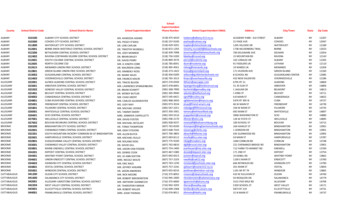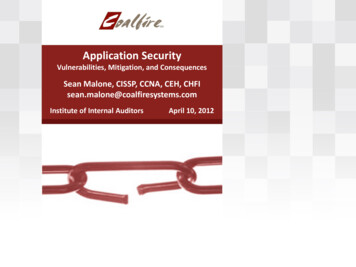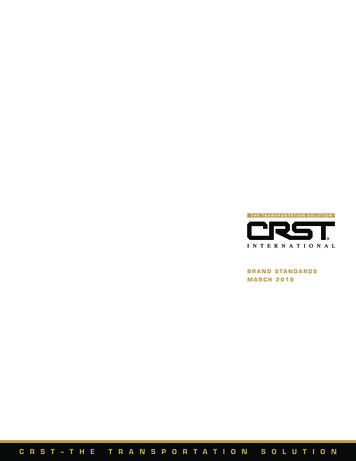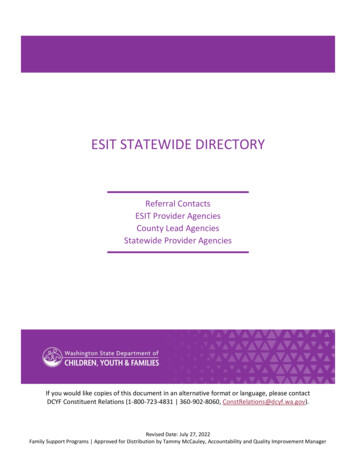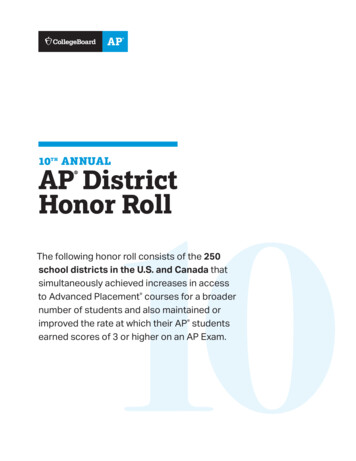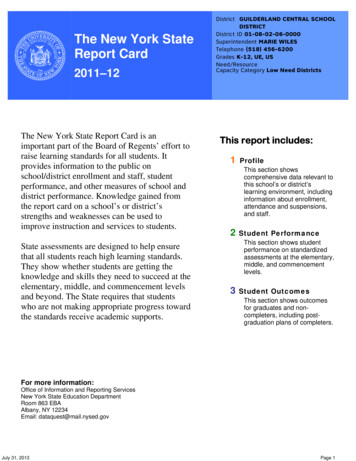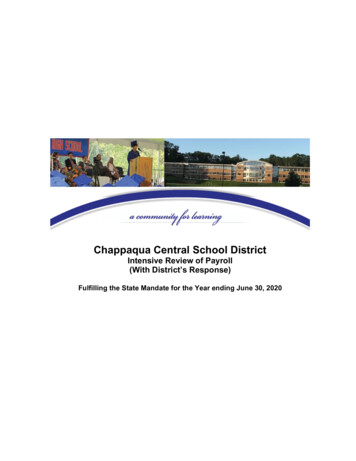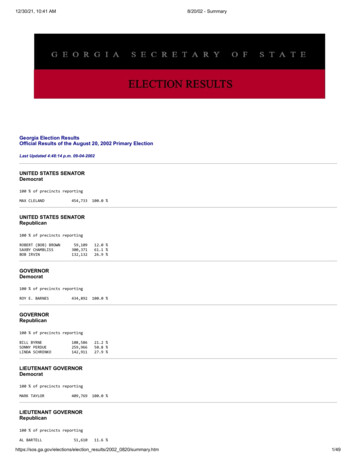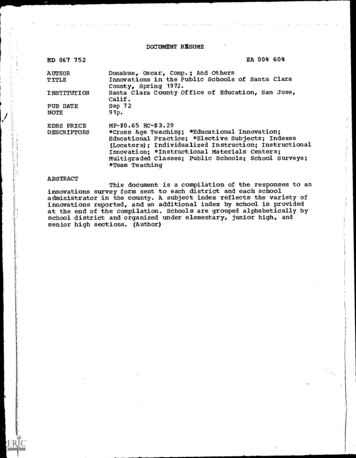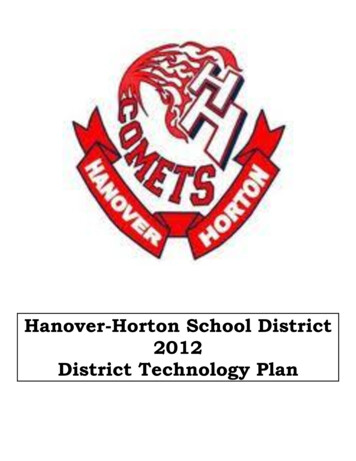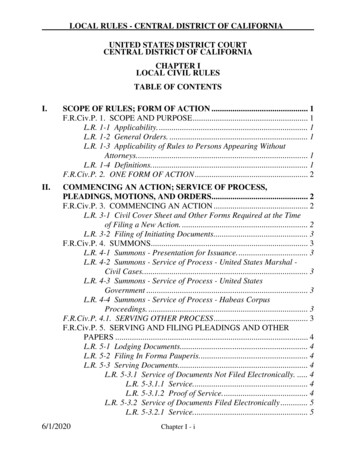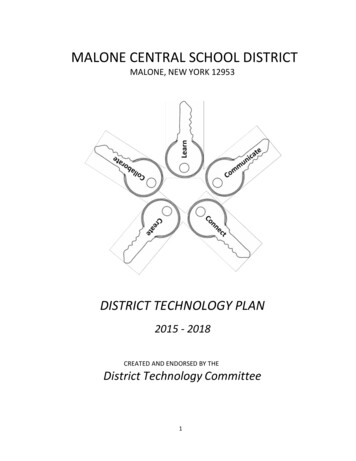
Transcription
MALONE CENTRAL SCHOOL DISTRICTMALONE, NEW YORK 12953DISTRICT TECHNOLOGY PLAN2015 - 2018CREATED AND ENDORSED BY THEDistrict Technology Committee1
Table of ContentsPrefaceExecutive SummaryMission StatementTechnology Mission StatementIntroduction and BackgroundVision StatementGoalsInformation Technology OverviewCurrent InventoryFranklin AcademyMiddle SchoolFlandersSt. Jo seph’sDavisBus GarageMaintenance BuildingTechnology Goals and Implementation ActivitiesGoal 1: InfrastructureGoal 2: Technology for StudentsStandardsProfiles for Technology Literate StudentsGoal 3: Technology for TeachersStandardsProfessional DevelopmentGoal 4: Technology for AdministratorsStandardsGoal 5: Budget2
PrefaceThere are certainly many good reasons for school districts to create and maintain plans for theuse of computer and other emerging technologies. First, each public school district in New YorkState is required to have such a plan as a matter of practice. Schools may also maintain eligibility for specific stateand federal funds, such as the e-rate. Certain forms of aid reimbursement also require that a plan be developed,approved, and kept on file. Technology plans also give the school community a sense of where the district isheaded and which specific forms of technology are priorities for implementation.Committee members agree that meeting the needs of our students by preparing them to be productive andcompetent lifelong learners is paramount. To say that technology has saturated the world in which we live, fallsshort of the realization that proficiency in the use of technology is absolutely essential. Before any plan isconstructed, an institution must clearly contemplate what impact it hopes to make on the academic success of thestudents that it graduates. The sole use of technology for “technology’s sake” is improper. Rather, eachimplementation of educational technology is only to be used as a tool to assist in reaching curricular goals.Students must be able to analyze critically an assigned task, define a viable course of action, and select from theavailable tools (including technology) to reach the intended outcome. Our nation’s primary resource for the newmillennium is information technology. In recognition of the scope and importance of information literacy, thecommittee has constructed this Plan using a sound rationale that reflects intended learner outcomes in eachcomponent created.To achieve our goal, as a district, we acknowledge a need for the following: A Technology Plan that demonstrates what we wish to achieve and is supported by the faculty,administration, Board of Education, and community; Sufficient monetary resources and budgetary support to achieve our technology goals; Adequate Instructional Technology (IT) staffing resources necessary to implement this Plan; Annual review and revision of this Plan; and A significant amount of training and support for classroom technology integration and for clerical andadministrative use of technology.Preparing our students for a rapidly changing future is only the beginning of what the committee hopes toaccomplish. We must go beyond the present and prepare our students to use available technology resources asthey prepare themselves for a future that we cannot yet envision.Respectfully submitted on behalf of:The Technology Planning CommitteeJerry Griffin, Superintendent, Committee Co-ChairpersonMark Dalton, Instructional Technology Coordinator, Committee Co-ChairpersonTravis Kench, NERIC: Senior Network & Systems Administrator3
Executive SummaryMission StatementThe mission of the Malone Central School District is to produce a healthy, responsible, productive citizen who hasacquired learning and is capable of contributing to a global community. We will accomplish this by providing aneffective, innovative, dedicated, motivated staff using a developmentally appropriate, relevant curriculum in anexciting, interactive environment conducive to learning by students prepared to learn.Technology Mission StatementInformational resources are changing the way that we learn, think, and live. Recognizing the need for innovation, theMalone Central School District will use technology to enable students, staff, and the community to enhance overallachievement in support of the Mission Statement of the District.Introduction and BackgroundLike many schools, the Malone Central School District has found that the Age of Information, brought on by theexplosive growth of computer and Internet technology, offers great potential for our students. It also has its share ofpitfalls. Schools must exercise caution in selecting from the vast array of available choices. The comparatively rapidobsolescence of computer equipment makes careful planning even more important. We must, therefore, plancarefully to make the best use of district dollars and still provide our students with the information and skillsnecessary to fulfill our Mission Statement.Vision StatementThe vision of the Malone Central School District technology plan is curriculum based. Technology is a key componentof an active learning environment, extending and deepening students’ experiences. By carefully choosing theappropriate technology to support learning, educators create a learning environment that encourages collaboration,constructivism, and higher order thinking skills. Technology is not used as an end in itself, but rather to support theteaching and learning process. Implementation of the technological infrastructure and support systems necessary toempower staff in every classroom and every school to enhance the individual learning of every student drives thisplan. In a lifetime of learning and employment, technology will be used to connect Malone students and staff toeach other and to the larger world to make learning and educational management more relevant and efficient intheir quest.Goals1. To create and maintain the hardware infrastructure and software by which the education process may betransformed and the goals for students and staff can be met.2. To facilitate the integration of technology in order to provide an enriching, challenging, and engagingenvironment for student learning to take place, and to ensure they leave our district with the requisitetechnological skills for future success.3. To help district staff become educational leaders in implementing the use of technology to positively impactstudent achievement by providing the support and professional development needed.4. To promote the vision for the role of technology in our district amongst our administrators and provide themwith the skills and knowledge to model the desired outcomes.5. To use deliberate budgeting to to not only build the infrastructure and support to accomplish the previousgoals, but to sustain the growth and changing nature of technology in our district.4
5
Information Technology OverviewThe Malone Central School District has been able to make significant gains in providing modern technology toolsthroughout the District. A strong commitment from the administration and Board of Education have allowed us tomove forward in our goal of ensuring that Malone’s students leave our schools with the skills they need to besuccessful in the 21st century.Current InventoryThe current inventory represents every piece of electronic equipment owned by the District and assigned to staff.The inventory is updated on a continual basis by NERIC and District personnel. The building snapshots belowrepresent the state of the inventory as of October 2014. The current inventory is available to administrators andother staff upon request.Franklin AcademyA strong network is in place utilizing three interconnected Data Communication and Server Rooms. A fiber opticconnection to the North Franklin Education Center is also in place. External communication is through a 1Gb line toNERIC. One-hundred and four computers are deployed in labs, one-hundred and eighty-three computers inclassrooms, and two-hundred and twenty-two devices in mobile labs. There are sixty Interactive Learning Systems inthe building.1The FA library/media center has forty computers, a mobile presentation cart that may be signed out, and anInteractive Learning System in its computer lab.A state-of-the-art Distance Learning facility is in use at FA, expanding course opportunities for students, and for ourteachers to reach students in other districts.Middle SchoolThe Middle School network utilizes three interconnected Data Communication and Server Rooms. Externalcommunication is through a 1Gb fiber optic line to Franklin Academy. Ninety-four computers are deployed in labs,one-hundred and seventy-five computers in classrooms, and one-hundred and nineteen devices in mobile labs.There are forty-nine Interactive Learning Systems in the building.The Middle School library/media center has fifty computers and one Interactive Learning System.FlandersThe Flanders network is supported by one Data Communication and Server Room. External communication isthrough a 1Gb fiber optic line to Franklin Academy. Twenty-four computers are deployed in a lab, sixty-sixcomputers in classrooms, and fifty devices in mobile labs. There are twenty-two Interactive Learning Systems in thebuilding.The Flanders library/media center contains eleven computers and an Interactive Learning System.1An Interactive Learning System is defined as a computer presentation center with sound, projection andSmartBoard.6
St. Joseph’sThe St. Joseph’s network is supported by one Data Communication and Server room. External communication isthrough a 1Gb fiber optic line to Franklin Academy. Twenty-four computers are deployed in a lab, forty-eightcomputers in classrooms, and ninety-six devices in mobile labs. There are twenty Interactive Learning Systems in thebuilding.The St. Joseph’s library/media center has thirteen computers and one Interactive Learning System.DavisA strong network is in place utilizing two interconnected Data Communication and Server Rooms. Externalcommunication is through a 1Gb fiber optic line to Franklin Academy. There are fifty computers in labs, one-hundredand twenty-five computers in classrooms, and fifty devices in mobile labs. There are forty-seven Interactive LearningSystems in the building.The Davis library/media center contains eighteen computers and one Interactive Learning System.Bus GarageThe bus garage has five computers connected to the District network via wireless connection.Maintenance BuildingThe maintenance building has six computers connected to the District network via wireless connection.7
Technology Goals and Implementation ActivitiesGoal 1: InfrastructureBased on the current needs assessment, the necessary hardware and software will be installed and maintained toprovide the District with a highly functional network (both wired and wireless) capable of carrying various necessaryvolumes and types of data. This integrated information system will allow every member of our educationalcommunity to access information resources; manipulate data, graphics, text, video, and sound; and communicate atany time, in any place, and on any topic with ease and efficiency.Rationale: As with any project, incorporating technology into the District will require a certain amount ofinfrastructure be put in place for the effort to be successful. In the case of technology, therequirements may be for the District to establish what kind of interconnecting of schools, personnel,students, and community it wants to accomplish. The establishment of this infrastructure wouldprovide a “road map” for purchases, budgeting, and assist in establishing priorities. Theinfrastructure will be flexible enough to allow the District to accomplish all its goals in technology,yet allow flexibility in the means by which those goals are accomplished.Activities: Build a district-wide information infrastructure capable of carrying the necessary volume of video,text, data, graphics, and voice at high speeds. Provide for adequate access to network and Internet resources in each instructional space by thesummer of 2015. Guarantee capacity and access during peak times and minimal downtime. Develop a plan for continued access to a range of online media sources, such asDiscovery Education, PBS Teachers, YouTube, etc.Activities: Develop an information system that is highly functional, adaptable to change, yet has great ease ofuse. Distributes such resources as library card catalogs, curricular materials, and electronicreference materials, making them accessible from school and home. Provides network security and protection of personal types of information. Automates routine record-keeping tasks, such as a student record database, student assessmentsoftware, networked grading and attendance programs, etc.Activities: Provide technology resources and equipment in such a way as to make them pervasive andconvenient. Equip each instructional and administrative area with the hardware necessary to meetsoftware needs and planned replacements (an ongoing process). Provide easy access to technology resources such as video projection devices, digitalcameras, scanners, multimedia devices, digital storage devices, etc. Planned replacements/upgrades of computers will occur on a six-year schedule, coincidingwith the District’s renewal of its Installment Purchase agreement with NERIC.8
Goal 2: Technology for StudentsIn the past few years, the primary mandate of New York State schools has been summed up as the necessity ofensuring that our students are “college and career ready.” The plain truth is that this goal cannot be met without theinclusion of technology as both a pedagogical tool and a topic of instruction in preparation for their future lives.Students with DisabilitiesFar from being a stumbling block, technology can, and should, be a leveler for students with disabilities. Allparties involved in the education of students with disabilities must be cognizant of the fact that students mayrequire modifications, accommodations, and assistive technology in order to be successful in the curricula of thegeneral and special education programs. As a result, all parties involved, general education teachers, specialeducation teachers, administrators, and related service providers, must work collaboratively to ensure that thesestudents have the technology necessary for them to achieve success.This requires that all parties in the school community understand that technology for students with disabilitiesoften goes beyond simply being a computer. For these students, it is specific hardware, software, and supportthat is necessary to adapt or augment their individualized education. Far from a one-size-fits-all approach, thisunderstanding may require a high degree of customization to find the right combinations of hardware, software,and support to ensure that all district students achieve success. For this reason, the district is fully aware of theimportance of, and committed to providing, high-quality professional development for those involved in thisprocess.Assistive Technology is a related service. Such services are provided to students who have been formallyidentified as having a disability, and upon the recommendation of the student’s IEP team. Various combinationsof hardware and software may be tried, and as stated above require the student’s entire team to workcollaboratively to find the right fit. Recommendations may be made for the rental or purchase of hardwareand/or software. These remain the property of the district and must be returned when the student leaves thedistrict.StandardsThe following standards2 have been developed by the International Society for Technology in Education (ISTE),and have been approved by the Technology Committee to serve as the standards to which our District shouldaspire for its students.1. Creativity and innovationStudents demonstrate creative thinking, construct knowledge, and develop innovative products and processesusing technology.a. Apply existing knowledge to generate new ideas, products, or processes.b. Create original works as a means of personal or group expression.c. Use models and simulations to explore complex systems and issues.d. Identify trends and forecast possibilities.2http://www.iste.org/docs/pdfs/20-14 ISTE Standards-S PDF.pdf (2007)9
2. Communication and collaborationStudents use digital media and environments to communicate and work collaboratively, including at a distance,to support individual learning and contribute to the learning of others.a. Interact, collaborate, and publish with peers, experts, or others employing a variety of digitalenvironments and media.b. Communicate information and ideas effectively to multiple audiences using a variety of media andformats.c. Develop cultural understanding and global awareness by engaging with learners of other cultures.d. Contribute to project teams to produce original works or solve problems.3. Research and information fluencyStudents apply digital tools to gather, evaluate, and use information.a. Plan strategies to guide inquiry.b. Locate, organize, analyze, evaluate, synthesize, and ethically use information from a variety of sourcesand media.c. Evaluate and select information sources and digital tools based on the appropriateness to specific tasks.d. Process data and report results.4. Critical thinking, problem solving, and decision makingStudents use critical thinking skills to plan and conduct research, manage projects, solve problems, and makeinformed decisions using appropriate digital tools and resources.a. Identify and define authentic problems and significant questions for investigation.b. Plan and manage activities to develop a solution or complete a project.c. Collect and analyze data to identify solutions and/or make informed decisions.d. Use multiple processes and diverse perspectives to explore alternative solutions.5. Digital citizenshipStudents understand human, cultural, and societal issues related to technology and practice legal and ethicalbehavior.a. Advocate and practice safe, legal, and responsible use of information and technology.b. Exhibit a positive attitude toward using technology that supports collaboration, learning, andproductivity.c. Demonstrate personal responsibility for lifelong learning.d. Exhibit leadership for digital citizenship.6. Technology operations and conceptsStudents demonstrate a sound understanding of technology concepts, systems, and operations.a. Understand and use technology systems.b. Select and use applications effectively and productively.c. Troubleshoot systems and applications.d. Transfer current knowledge to learning of new technologies.10
Profiles for Technology Literate StudentsCreated by ISTE to accompany the above standards, these profiles provide examples of the types of learningactivities in which students might engage; they are not be viewed as concrete requirements, but rather asexamples to guide instructional choices. 3 The numbers in parenthesis reference the standards.Grades PK-21. Illustrate and communicate original ideas and stories using digital tools and media-rich resources. (1, 2)2. Identify, research, and collect data on an environmental issue using digital resources and propose adevelopmentally appropriate solution. (1, 3, 4)3. Engage in learning activities with learners from multiple cultures through e-mail and other electronicmeans. (2, 6)4. In a collaborative work group, use a variety of technologies to produce a digital presentation or productin a curriculum area. (1, 2, 6)5. Find and evaluate information related to a current or historical person or event using digital resources.(3)6. Use simulations and graphical organizers to explore and depict patterns of growth such as the life cyclesof plants and animals. (1, 3, 4)7. Demonstrate the safe and cooperative use of technology. (5)8. Independently apply digital tools and resources to address a variety of tasks and problems. (4, 6)9. Communicate about technology using developmentally appropriate and accurate terminology. (6)10. Demonstrate the ability to navigate in virtual environments such as electronic books, simulationsoftware, and Web sites. (6)Grades 3-51. Produce a media-rich digital story about a significant local event based on first-person interviews. (1, 2, 3,4)2. Use digital-imaging technology to modify or create works of art for use in a digital presentation. (1, 2, 6)3. Recognize bias in digital resources while researching an environmental issue with guidance from theteacher. (3, 4)4. Select and apply digital tools to collect, organize, and analyze data to evaluate theories or testhypotheses. (3, 4, 6)5. Identify and investigate a global issue and generate possible solutions using digital tools and resources.(3, 4)6. Conduct science experiments using digital instruments and measurement devices. (4, 6)7. Conceptualize, guide, and manage individual or group learning projects using digital planning tools withteacher support. (4, 6)8. Practice injury prevention by applying a variety of ergonomic strategies when using technology. (5)9. Debate the effect of existing and emerging technologies on individuals, society, and the globalcommunity. (5, 6)10. Apply previous knowledge of digital technology operations to analyze and solve current hardware andsoftware problems. (4, nt-profiles-en.pdf?sfvrsn 4 (2007)11
Grades 6-81. Describe and illustrate a content-related concept or process using a model, simulation, or conceptmapping software. (1, 2)2. Create original animations or videos documenting school, community, or local events. (1, 2, 6)3. Gather data, examine patterns, and apply information for decision making using digital tools andresources. (1, 4)4. Participate in a cooperative learning project in an online learning community. (2)5. Evaluate digital resources to determine the credibility of the author and publisher and the timeliness andaccuracy of the content. (3)6. Employ data-collection technology such as probes, handheld devices, and geographic mapping systemsto gather, view, analyze, and report results for content-related problems. (3, 4, 6)7. Select and use the appropriate tools and digital resources to accomplish a variety of tasks and to solveproblems. (3, 4, 6)8. Use collaborative electronic authoring tools to explore common curriculum content from multiculturalperspectives with other learners. (2, 3, 4, 5)9. Integrate a variety of file types to create and illustrate a document or presentation. (1, 6)10. Independently develop and apply strategies for identifying and solving routine hardware and softwareproblems. (4, 6)Grades 9-121. Design, develop, and test a digital learning game to demonstrate knowledge and skills related tocurriculum content. (1, 4)2. Create and publish an online art gallery with examples and commentary that demonstrate anunderstanding of different historical periods, cultures, and countries. (1, 2)3. Select digital tools or resources to use for a real-world task and justify the selection based on theirefficiency and effectiveness. (3, 6)4. Employ curriculum-specific simulations to practice critical-thinking processes. (1, 4)5. Identify a complex global issue, develop a systematic plan of investigation, and present innovativesustainable solutions. (1, 2, 3, 4)6. Analyze the capabilities and limitations of current and emerging technology resources and assess theirpotential to address personal, social, lifelong learning, and career needs. (4, 5, 6)7. Design a Website that meets accessibility requirements. (1, 5)8. Model legal and ethical behaviors when using information and technology by properly selecting,acquiring, and citing resources. (3, 5)9. Create media-rich presentations for other students on the appropriate and ethical use of digital tools andresources. (1, 5)10. Configure and troubleshoot hardware, software, and network systems to optimize their use for learningand productivity. (4, 6)12
Goal 3: Technology for TeachersIf we are to prepare our students for life in the 21st century, then our educators must themselves be able toeffectively use and model the technologies that will lead to their success. The individual technologies change at anincreasingly rapid pace. Therefore, it is essential that educators stay current and proficient.StandardsThe following standards have been developed by the International Society for Technology in Education (ISTE),and have been approved by the Technology Committee to serve as the standards to which our District shouldaspire.41. Facilitate and inspire student learning and creativityTeachers use their knowledge of subject matter, teaching and learning, and technology to facilitate experiencesthat advance student learning,creativity, and innovation in both face-to-face and virtual environments.a. Promote, support, and model creative and innovative thinking and inventiveness.b. Engage students in exploring real-world issues and solving authentic problems using digital tools andresources.c. Promote student reflection using collaborative tools to reveal and clarify students’ conceptualunderstanding and thinking, planning, and creative processes.d. Model collaborative knowledge construction by engaging in learning with students, colleagues, andothers in face-to-face and virtual environments.2. Design and develop digital age learning experiences and assessmentsTeachers design, develop, and evaluate authentic learning experiences and assessments incorporatingcontemporary tools and resources to maximize content learning in context and to develop the knowledge, skills,and attitudes identified in the Standards S (see Goal 2).a. Design or adapt relevant learning experiences that incorporate digital tools and resources to promotestudent learning and creativityb. Develop technology-enriched learning environments that enable all students to pursue their individualcuriosities and become active participants in setting their own educational goals, managing their ownlearning, and assessing their own progressc. Customize and personalize learning activities to address students’ diverse learning styles, workingstrategies, and abilities using digital tools and resourcesd. Provide students with multiple and varied formative and summative assessments aligned with contentand technology standards, and use resulting data to inform learning and teaching3. Model digital age work and learningTeachers exhibit knowledge, skills, and work processes representative of an innovative professional in a globaland digital society.a. Demonstrate fluency in technology systems and the transfer of current knowledge to new technologies .and situationsb. Collaborate with students, peers, parents, and community members using digital tools and resources tosupport student success and innovationc. Communicate relevant information and ideas effectively to students, parents, and peers using a varietyof digital age media and formats4http://www.iste.org/docs/pdfs/20-14 ISTE Standards-T PDF.pdf (2008)13
d. Model and facilitate effective use of current and emerging digital tools to locate, analyze, evaluate, anduse information resources to support research and learning4. Promote and model digital citizenship and responsibilityTeachers understand local and global societal issues and responsibilities in an evolving digital culture and exhibitlegal and ethical behavior in their professional practices.a. Advocate, model, and teach safe, legal, and ethical use of digital information and technology, includingrespect for copyright, intellectual property, and the appropriate documentation of sourcesb. Address the diverse needs of all learners by using learner-centered strategies providing equitable accessto appropriate digital tools and resourcesc. Promote and model digital etiquette and responsible social interactions related to the use of technologyand informationd. Develop and model cultural understanding and global awareness by engaging with colleagues andstudents of other cultures using digital age communication and collaboration tools5. Engage in professional growth and leadershipTeachers continuously improve their professional practice, model lifelong learning, and exhibit leadership intheir school and professional community by promoting and demonstrating the effective use of digital tools andresourcesa. Participate in local and global learning communities to explore creative applications of technology toimprove student learningb. Exhibit leadership by demonstrating a vision of technology infusion, participating in shared decisionmaking and community building, and developing the leadership and technology skills of othersc. Evaluate and reflect on current research and professional practice on a regular basis to make effectiveuse of existing and emerging digital tools and resources in support of student learningd. Contribute to the effectiveness, vitality, and self-renewal of the teaching profession and of their schoolcommunity.Professional DevelopmentRationale: It is clear that any technology initiative will need to have the support of the Malone Central SchoolDistrict staff. This is particularly important because of the decision to let the curriculum dictate technologyinstead of technology dictating curriculum. It is therefore important that we establish what is critical for allstaff to know and to provide multiple opportunities for them to receive this training. It is also important thatwe support those staff members who need more than the basics by offering a more in-depth learningopportunity. Staff members may receive one in-service credit for the completion of every ten hours ofapproved training.Activity:The Instructional Technology Coordinator will assess the current needs and organize training tailoredto these needs on an ongoing basis throughout the year. with assistance from the TechnologyCommittee. In the Fall of each ye
The vision of the Malone Central School District technology plan is curriculum based. Technology is a key component of an active learning environment, extending and deepening students' experiences. By carefully choosing the appropriate technology to support learning, educators create a learning environment that encourages collaboration,
